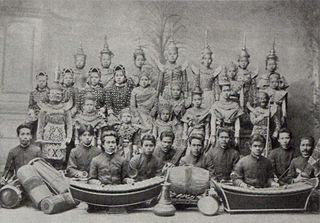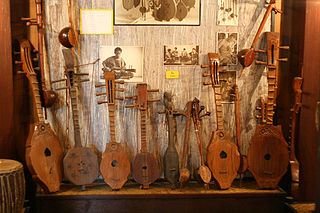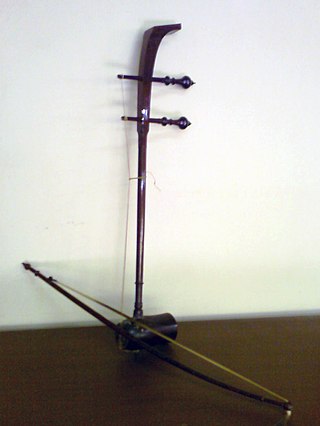
The cello ( CHEL-oh), or violoncello ( VY-ə-lən-CHEL-oh, Italian pronunciation:[vjolonˈtʃɛllo]), is a bowed (sometimes plucked and occasionally hit) string instrument of the violin family. Its four strings are usually tuned in perfect fifths: from low to high, C2, G2, D3 and A3. The viola's four strings are each an octave higher. Music for the cello is generally written in the bass clef, with tenor clef, and treble clef used for higher-range passages.

The double bass, also known as the upright bass, the acoustic bass, or simply the bass, is the largest and lowest-pitched chordophone, in the modern symphony orchestra. Similar in structure to the cello, it has four or five strings.

The violin, colloquially known as a fiddle, is a wooden chordophone, and is the smallest, and thus highest-pitched instrument (soprano) in regular use in the violin family. Smaller violin-type instruments exist, including the violino piccolo and the pochette, but these are virtually unused. Most violins have a hollow wooden body, and commonly have four strings, usually tuned in perfect fifths with notes G3, D4, A4, E5, and are most commonly played by drawing a bow across the strings. The violin can also be played by plucking the strings with the fingers (pizzicato) and, in specialized cases, by striking the strings with the wooden side of the bow.

The viola ( vee-OH-lə, Italian:[ˈvjɔːla,viˈɔːla]) is a string instrument that is usually bowed. Slightly larger than a violin, it has a lower and deeper sound. Since the 18th century, it has been the middle or alto voice of the violin family, between the violin (which is tuned a perfect fifth higher) and the cello (which is tuned an octave lower). The strings from low to high are typically tuned to C3, G3, D4, and A4.

In musical instrument classification, string instruments or chordophones, are musical instruments that produce sound from vibrating strings when a performer plays or sounds the strings in some manner.

The music of Thailand reflects its geographic position at the intersection of China and India, as well as historical trade routes including with Africa, Greece and Rome.

The morin khuur, also known as the horsehead fiddle, is a traditional Mongolian bowed stringed instrument. It is one of the most important musical instruments of the Mongol people, and is considered a symbol of the nation of Mongolia. The morin khuur is one of the Masterpieces of the Oral and Intangible Heritage of Humanity identified by UNESCO.

The erhu is a Chinese two-stringed bowed musical instrument, more specifically a spike fiddle, which may also be called a Southern Fiddle, and is sometimes known in the Western world as the Chinese violin or a Chinese two-stringed fiddle.

Gamelan gong kebyar is a style or genre of Balinese gamelan music of Indonesia. Kebyar means "to flare up or burst open", and refers to the explosive changes in tempo and dynamics characteristic of the style.

The guqin is a plucked seven-string Chinese musical instrument. It has been played since ancient times, and has traditionally been favoured by scholars and literati as an instrument of great subtlety and refinement, as highlighted by the quote "a gentleman does not part with his qin or se without good reason," as well as being associated with the ancient Chinese philosopher Confucius. It is sometimes referred to by the Chinese as "the father of Chinese music" or "the instrument of the sages". The guqin is not to be confused with the guzheng, another Chinese long stringed instrument also without frets, but with moveable bridges under each string.

The term Chinese orchestra is most commonly used to refer to the modern Chinese orchestra that is found in China and various overseas Chinese communities. This modern Chinese orchestra first developed out of Jiangnan sizhu ensemble in the 1920s into a form that is based on the structure and principles of a Western symphony orchestra but using Chinese instruments. The orchestra is divided into four sections – wind, plucked strings, bowed strings, and percussion, and usually performs modernized traditional music called guoyue. The orchestra may be referred to as Minzu Yuetuan or Minyuetuan in mainland China, Chung Ngok Tuen in Hong Kong, Huayuetuan in Southeast Asia, or Guoyuetuan in Taiwan.

Huqin is a family of bowed string instruments, more specifically, a spike fiddle popularly used in Chinese music. The instruments consist of a round, hexagonal, or octagonal sound box at the bottom with a neck attached that protrudes upwards. They also usually have two strings, and their soundboxes are typically covered with either snakeskin or thin wood. Huqin instruments usually have two tuning pegs, one peg for each string. The pegs are attached horizontally through holes drilled in the instrument's neck. Most huqin have the bow hair pass in between the strings. Exceptions to having two strings and pegs include variations of huqin with three, four, and sometimes even more than five. These include the zhuihu, a three stringed huqin, the sihu, a huqin of Mongolian origin, and the sanhu, a lesser-known three-stringed variation.

The tro is Cambodia's traditional spike fiddle, a bowed string instrument that is held and played vertically. Spike fiddles have a handle that passes through the resonator, often forming a spike, on the bottom side where it emerges. The family is similar or distantly related to the Chinese erhu or huqin. The instruments have a soundbox at the bottom of the stick, covered with leather or snake skin. Strings run from pegs at the top of the stick and secured at the bottom, running across the soundbox. The larger the soundbox, the lower the pitch range. Instruments in this family include the two-stringed tro ou, tro sau thom, tro sau toch and tro che, as well as the three-stringed tro Khmer spike fiddle. The two-stringed tros are tuned in a fifth, while the three-stringed tro Khmer is tuned in fourths. The tros, with the exception of the tro Khmer, are strung so that the bowstring is permanently placed between the two stings. When the musician plays, the placement of the bow causes the strings to be played at once, one from below and one from above. In contrast, western fiddles are played with the bow pushing on each string from the outside, as is also the case with the tro khmer.

The saw sam sai is a traditional bowed string instrument of Thailand. It is in the saw family of Thai fiddles, which also includes the saw u and saw duang, but unlike the other two, it has three strings and a bow that is separate from the instrument.

The erxian is a Chinese bowed string instrument in the huqin family of instruments. It has two strings and is used primarily in Cantonese music, most often in "hard string" chamber ensembles. In the 1920s, following the development of the gaohu, the erxian experienced a decline and since the late 20th century has been little used outside the tradition of Cantonese opera.
Traditional Thai musical instruments are the musical instruments used in the traditional and classical music of Thailand. They comprise a wide range of wind, string, and percussion instruments played by both the Thai majority as well as the nation's ethnic minorities.

The sueng is a plucked fretted lute from the northern (Lanna) region of Thailand. The instrument is made from hardwood and its strings are most often made of steel wire. It has nine bamboo frets.

The saw duang is a two-stringed instrument used in traditional Thai music. The sound is produced by the bow made from horsetail hair which goes between the strings made from silk. The bow has to be tilted to switch from one string to another. Saw duang is light and played vertically on the lap. It creates a bright tone unlike the Saw u which produces a mellow sound. Another instrument which is similar to the Saw duang is the Chinese stringed instrument called Huqin.
Krachappi , also spelled Grajabpi, is plucked, fretted lute of Thailand, used in central Thai classical music. The Department of Cultural Promotion listed Krachappi as a cultural heritage in 2011. Krachappi is an ancient Thai instrument and has been with the Thai people for over a century. The appearance, playing method, and song of Krachappi are all associated with Thai history. Thai music instruments are divided into 4 groups, namely, strum, string, percussion, and brass. It has four strings in two courses that are plucked with a plectrum and are constructed of teak or jackfruit wood. It can be played by holding the wand, which is composed of thin wooden planks, in your right hand and flicking the wires in and out while pressing the string with your left finger. Krachappi usually plays in a band called Mahori with four to eight instruments.

The tube zither is a stringed musical instrument in which a tube functions both as an instrument's neck and its soundbox. As the neck, it holds strings taut and allows them to vibrate. As a soundbox, it modifies the sound and transfers it to the open air. The instruments are among the oldest of chordophones, being "a very early stage" in the development of chordophones, and predate some of the oldest chordophones, such as the Chinese Se, zithers built on a tube split in half. Most tube zithers are made of bamboo, played today in Madagascar, India, Southeast Asia and Taiwan. Tube zithers made from other materials have been found in Europe and the United States, made from materials such as cornstalks and cactus.



















